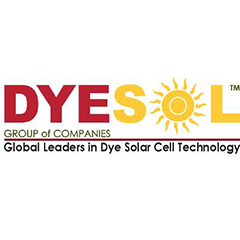Sydney, Australia, 11 July 2013 – Announced today in the prestigious scientific journal, Nature, is a paper by a team led by the ‘Father of DSC’ Professor Michael Graetzel describing a new deposition process to create the light harvesting pigment for solid-state dye solar cells. Cells fabricated using this technique and incorporating Dyesol’s key DSC input materials and specially formulated 18NR-T Titania Paste have established a new world record efficiency of 15% for a solid-state Dye Solar Cell (DSC).
“The recent breakthroughs in solid-state Dye Solar Cell technology are truly astonishing. This is the dawn of a new age in efficient and affordable renewable energy”, said Dyesol Executive Chairman, Richard Caldwell.
“The EPFL and Professor Graetzel choose Dyesol as their materials supplier for achieving best results and, most importantly, for commercialisation projects, reproducible results. These are the same benefits that we will deliver to our major project partners as Dyesol has ongoing access to this improved technology and the arguments for large scale industrialisation are now very compelling.”
Professor Graetzel responded: “Our research work on solid-state dye sensitised solar cells is now achieving efficiencies exceeding 15% and our cells have been externally validated with a world record of 14.1%. At these efficiencies the technology is extremely competitive with conventional solar cells particularly when you consider dye sensitised solar cells do not need perfect sunlight conditions to effectively produce energy. In the task of scale up from small laboratory sized cells to industrial scale, we are particularly encouraged by the program from Dyesol to allow commercial deployment of this game changing technology in the shortest possible timeframe.”
This independently certified efficiency result eclipses all previous certified public records and is now the official world-record for Dye Solar Cell technology performance. The DSC world record efficiency result of 14.1% catapults the energy output of DSC devices to the next level. It is relatively cheap and provides competitive efficiency. One of the many advantages DSC technology offers over traditional silicon solar panels is the consistent energy output in low-light, dawn, dusk, cloudy, indoor/artificial, and shaded or indirect-light conditions. This means that the cumulative seasonal energy output from DSC over the course of a cloudy autumn, dreary winter, and whole year is much greater.
The two-step deposition process highlighted in EPFL’s report published in Nature is, importantly, reproducible – a crucial factor for commercialisation of any technology requiring large scale quantities of product to satisfy a mass-market.
This important technology breakthrough follows two other recent announcements from Australian clean-tech and award-winning solar technology innovator, Dyesol Ltd (ASX: DYE). Dyesol is working closely with EPFL and advancing commercialisation of the mesoscopic technology called Dye Solar Cells by embedding the revolutionary technology onto manufacturing partners’ building products, such as steel roofing and glass building façade to meet the growing demand for building integrated photovoltaic products which turn the building envelope into an active power generator for building occupants and the grid.
Read online and access PDF – click here >>
About EPFL
DSC technology was invented at the Institute of Physical Chemistry, of the Swiss Federal Institute of Technology in Lausanne, Switzerland in 1988 by Brian O’Regan and Michael Graetzel. Their paper ‘A low-cost, high-efficiency solar cell based on dye-sensitized colloidal TiO2 films’ published in 1991 in the journal, Nature, was the catalyst that spawned a whole new industry and a whole new way of looking at harvesting electrical power from sunlight. Since that time Professor Graetzel, now at Switzerland’s École Polytechnique Fédérale de Lausanne (EPFL), has remained strongly focused on DSC technology, received numerous awards and accolades in relation to the invention of DSC, and maintained close links to Dyesol as Chairman of Dyesol’s Technical Advisory Board.
About the Company – Dyesol Limited
Dyesol is a global supplier of Dye Solar Cell (DSC) materials, technology and know-how. DSC is a photovoltaic technology enabling metal, glass and polymeric based products in the building, transport and electronics sectors to generate energy and improve energy efficiency. Dyesol partners with leading multinational companies who possess significant market share and established routes-to-market. The company is listed on the Australian Stock Exchange (DYE), the German Open Market (D5I), and is trading in the USA on the OTCQX (DYSOY). www.dyesol.com Join Dyesol Mailing List
About the Technology – Dye Solar Cells
Dye Solar Cell (DSC) technology is a third generation photovoltaic technology and is very different from first generation silicon solar cells and second generation thin film technologies. Dye Solar Cell (DSC) technology can best be described as ‘artificial photosynthesis’ using an electrolyte, a layer of titania (a pigment used in white paints and tooth paste) and ruthenium dye deposited on glass, metal or polymer substrates. Compared to conventional silicon based photovoltaic technology, Dyesol’s technology has lower cost to manufacture, less embodied energy, and produces stable electricity in low conditions such as shade, dappled light and low light. DSC technology can be directly incorporated and embedded into building materials to make solar windows or solar enabled roofing material and incorporated into other consumer products.



























